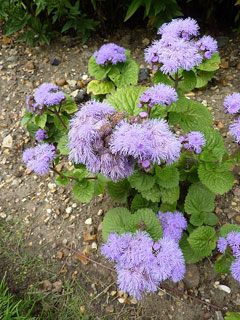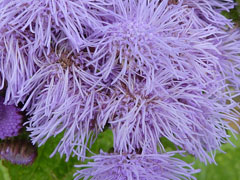 |
|
http://commons.wikimedia.org/wiki/User:Magnus_Manske |
 |
| http://commons.wikimedia.org/wiki/User:Magnus_Manske |
Translate this page:
Summary
Bloom Color: Blue, Pink, Purple, White. Main Bloom Time: Early summer, Early fall, Late summer, Late spring, Mid summer, Mid spring. Form: Rounded.
Physical Characteristics

 Ageratum houstonianum is a ANNUAL growing to 0.3 m (1ft) by 0.3 m (1ft in) at a medium rate.
Ageratum houstonianum is a ANNUAL growing to 0.3 m (1ft) by 0.3 m (1ft in) at a medium rate.
See above for USDA hardiness. It is hardy to UK zone 8. It is in flower from June to October, and the seeds ripen from August to October. The species is hermaphrodite (has both male and female organs) and is pollinated by Lepidoptera (Moths & Butterflies).
Suitable for: light (sandy), medium (loamy) and heavy (clay) soils. Suitable pH: mildly acid, neutral and basic (mildly alkaline) soils. It cannot grow in the shade. It prefers dry or moist soil.
UK Hardiness Map
US Hardiness Map
Synonyms
A. caeruleum. A. mexicanum.
Plant Habitats
Woodland Garden Sunny Edge;
Edible Uses
References More on Edible Uses
Medicinal Uses
Plants For A Future can not take any responsibility for any adverse effects from the use of plants. Always seek advice from a professional before using a plant medicinally.
Anodyne
The juice of the plant is used externally to treat cuts and wounds[272].
References More on Medicinal Uses
The Bookshop: Edible Plant Books
Our Latest books on Perennial Plants For Food Forests and Permaculture Gardens in paperback or digital formats.

Edible Tropical Plants
Food Forest Plants for Hotter Conditions: 250+ Plants For Tropical Food Forests & Permaculture Gardens.
More

Edible Temperate Plants
Plants for Your Food Forest: 500 Plants for Temperate Food Forests & Permaculture Gardens.
More

More Books
PFAF have eight books available in paperback and digital formats. Browse the shop for more information.
Shop Now
Other Uses
References More on Other Uses
Cultivation details
Landscape Uses:Border, Container, Massing, Rock garden, Specimen. Grows well in ordinary garden soil[200]. Requires a sheltered position in full sun[200]. This species is not hardy in the colder areas of the country, it tolerates temperatures down to between -5 and -10°c[200]. A very ornamental plant[1], the flowers are very attractive to butterflies[30]. The removal of dead flowers will extend the flowering season. Special Features:North American native, Attracts butterflies, Suitable for cut flowers, Seldomly reblooms.
References Carbon Farming Information and Carbon Sequestration Information
Temperature Converter
Type a value in the Celsius field to convert the value to Fahrenheit:
Fahrenheit:
The PFAF Bookshop
Plants For A Future have a number of books available in paperback and digital form. Book titles include Edible Plants, Edible Perennials, Edible Trees,Edible Shrubs, Woodland Gardening, and Temperate Food Forest Plants. Our new book is Food Forest Plants For Hotter Conditions (Tropical and Sub-Tropical).
Shop Now
Plant Propagation
Seed - surface sow March in a light position in a greenhouse. The seed usually germinates in 1 - 3 weeks at 20°c[133]. When large enough to handle, prick the seedlings out and plant them out after the last expected frosts.
Other Names
If available other names are mentioned here
Native Range
NORTHERN AMERICA: Mexico (Chiapas, Hidalgo, Jalisco, Morelos, Nayarit, Oaxaca, Veracruz de Ignacio de la Llave) SOUTHERN AMERICA: Belize, Honduras
Weed Potential
Right plant wrong place. We are currently updating this section.
Please note that a plant may be invasive in one area but may not in your area so it's worth checking.
Conservation Status
IUCN Red List of Threatened Plants Status :

Growth: S = slow M = medium F = fast. Soil: L = light (sandy) M = medium H = heavy (clay). pH: A = acid N = neutral B = basic (alkaline). Shade: F = full shade S = semi-shade N = no shade. Moisture: D = dry M = Moist We = wet Wa = water.
Now available:
Food Forest Plants for Mediterranean Conditions
350+ Perennial Plants For Mediterranean and Drier Food Forests and Permaculture Gardens.
[Paperback and eBook]
This is the third in Plants For A Future's series of plant guides for food forests tailored to
specific climate zones. Following volumes on temperate and tropical ecosystems, this book focuses
on species suited to Mediterranean conditions—regions with hot, dry summers and cool, wet winters,
often facing the added challenge of climate change.
Read More
Expert comment
Author
Mill.
Botanical References
72200
Links / References
For a list of references used on this page please go here
Readers comment